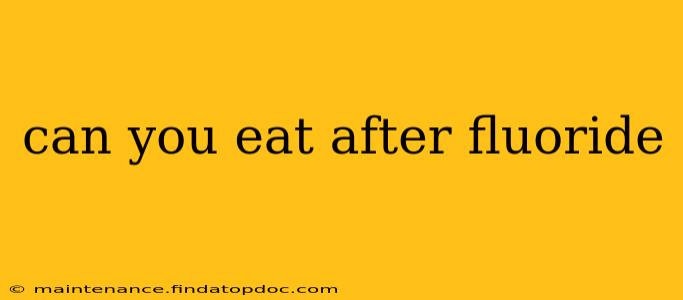Can You Eat After Fluoride Treatment? A Comprehensive Guide
Many people wonder about what they can and can't do after a fluoride treatment, especially regarding eating and drinking. The short answer is: yes, you can eat after a fluoride treatment, but with some important caveats. The specifics depend on the type of fluoride treatment you received.
This guide will explore different fluoride treatments and provide clear guidelines on what to expect and when it's safe to eat and drink.
What are the different types of fluoride treatments?
There are several ways fluoride is applied, each with its own set of post-treatment instructions:
-
Fluoride Toothpaste: This is the most common form of fluoride exposure. After brushing with fluoride toothpaste, there are no restrictions on eating or drinking.
-
Fluoride Mouthwash: Similar to toothpaste, rinsing with fluoride mouthwash doesn't require any waiting period before eating or drinking.
-
Professional Topical Fluoride Applications (in-office): These treatments are applied by a dentist or hygienist in the dental office. The specific instructions will vary depending on the type of fluoride varnish or gel used. Generally, your dentist will advise you to avoid eating, drinking, or rinsing for at least 30 minutes after the treatment to allow the fluoride to fully absorb into your teeth's enamel.
-
Fluoride Varnish: This is often applied to children's teeth and is usually followed by a similar waiting period of 30 minutes before eating, drinking or brushing. The dentist might also recommend avoiding sticky foods for several hours to allow the varnish to completely set.
How long should I wait to eat after a fluoride treatment?
This is crucial and varies depending on the method.
- Fluoride Toothpaste & Mouthwash: No waiting period is needed.
- Professional Topical Applications (in-office): Your dentist will provide specific instructions, but a 30-minute waiting period is common. This allows the fluoride to be absorbed into the enamel effectively.
What should I avoid eating immediately after fluoride treatment?
While you can generally eat after the recommended waiting period, it's best to avoid certain foods and drinks immediately after professional fluoride treatments:
- Highly acidic foods and drinks: These can compromise the fluoride's effectiveness and potentially erode enamel. Examples include citrus fruits, sodas, and juices.
- Sticky or sugary foods: These can adhere to the fluoride application, interfering with its ability to penetrate the teeth properly.
What if I accidentally eat or drink something right after a fluoride treatment?
If you accidentally consume something shortly after your professional treatment, don't panic. The fluoride will still offer some benefits. However, it might be less effective than if you had waited. It's best to contact your dentist if you have concerns.
Does fluoride treatment stain my teeth?
Fluoride treatments themselves generally do not stain teeth. However, the staining might result from food or drinks consumed shortly after the treatment and before it has adequately set.
Is fluoride treatment safe for children?
Fluoride treatments are generally safe for children, although the recommended waiting periods and types of treatments might differ based on age and the child's specific needs. Your dentist or pediatrician can advise you on appropriate fluoride treatments for your child.
In summary:
Remember to always follow your dentist's specific instructions following any fluoride treatment. While waiting 30 minutes after a professional application is common, the waiting time could be shorter or longer depending on the fluoride product used. Pay attention to your dentist's recommendations for optimal results and to prevent any potential issues. By following these guidelines, you can maximize the benefits of your fluoride treatment and maintain good oral health.
